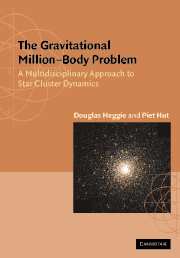Book contents
- Frontmatter
- Contents
- Preface
- PART I INTRODUCTIONS
- PART II THE CONTINUUM LIMIT: N → ∞
- PART III MEAN FIELD DYNAMICS: N = 106
- PART IV MICROPHYSICS: N = 2
- PART V GRAVOTHERMODYNAMICS: N = 106
- PART VI GRAVITATIONAL SCATTERING: N = 3
- PART VII PRIMORDIAL BINARIES: N = 4
- PART VIII POST-COLLAPSE EVOLUTION: N = 106
- PART IX STAR CLUSTER ECOLOGY
- Appendix A A Simple N-Body Integrator
- Appendix B Hints to Solution of Problems
- References
- Index
PART IV - MICROPHYSICS: N = 2
Published online by Cambridge University Press: 05 June 2012
- Frontmatter
- Contents
- Preface
- PART I INTRODUCTIONS
- PART II THE CONTINUUM LIMIT: N → ∞
- PART III MEAN FIELD DYNAMICS: N = 106
- PART IV MICROPHYSICS: N = 2
- PART V GRAVOTHERMODYNAMICS: N = 106
- PART VI GRAVITATIONAL SCATTERING: N = 3
- PART VII PRIMORDIAL BINARIES: N = 4
- PART VIII POST-COLLAPSE EVOLUTION: N = 106
- PART IX STAR CLUSTER ECOLOGY
- Appendix A A Simple N-Body Integrator
- Appendix B Hints to Solution of Problems
- References
- Index
Summary
The following three chapters are devoted to two-body interactions in the context of the million-body problem. Chapter 13 shows that these cause neighbouring orbits to diverge with an approximately exponential time dependence. Beginning with the three-body problem, we go on to investigate the N-dependence of the e-folding time scale for the divergence. Were late the phenomenon to the exponential divergence of geodesics in an alternative formulation of the problem.
Chapter 14 is quintessential collisional stellar dynamics. Here we consider the cumulative effect of many two-body encounters on the motion of a single star: the theory of two-body relaxation. We develop a number of standard formulae for the first and second moments of the cumulative change in its velocity. The first moment corresponds to the phenomenon of dynamical friction. We then go on to incorporate this theory into an evolution equation (the Fokker–Planck equation) for the distribution function. We approximate this equation in a form appropriate to the situation in stellar dynamics, when the time scale of relaxation is much longer than that of orbital motions. This also incorporates the evolution which may result from slow changes in the potential.
Chapter 15 takes a close look at the two-body problem itself. We show, in particular, that the two-body collision singularity is a removable singularity. This introduces a number of topics which might seem surprising in the context of the million-body problem: the Lenz vector, quaternions, the Hopf map, the simple harmonic oscillator, and even a transformation into four dimensions.
- Type
- Chapter
- Information
- The Gravitational Million–Body ProblemA Multidisciplinary Approach to Star Cluster Dynamics, pp. 119Publisher: Cambridge University PressPrint publication year: 2003



